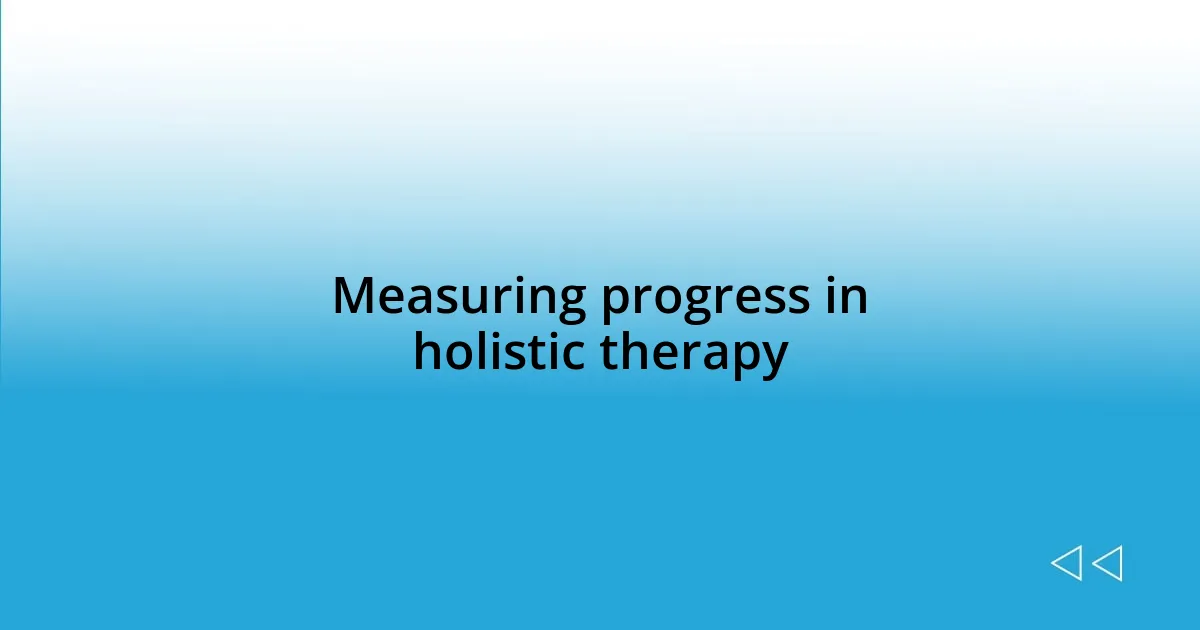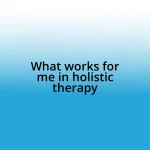Key takeaways:
- Holistic therapy emphasizes treating the whole person—mind, body, and spirit—enhancing self-awareness and fostering community support.
- Key techniques include meditation, aromatherapy, yoga, acupuncture, and nutritional counseling, which can be personalized for individual healing journeys.
- Mindfulness practices, such as conscious breathing and savoring meals, can positively impact daily life and improve relationships through attentive communication.
- Long-term benefits include increased emotional resilience, self-awareness, and the ability to respond thoughtfully to challenging situations.

Understanding holistic therapy benefits
Holistic therapy offers profound benefits by treating not just the symptoms, but the entire person—mind, body, and spirit. I remember a time in my life when stress seemed to dictate my every move. Engaging in holistic practices, like meditation and aromatherapy, helped me rediscover a sense of balance that I hadn’t felt in years. Have you ever felt lost, as if mere survival was your only goal?
One of the most powerful aspects of holistic therapy is its emphasis on self-awareness. During my sessions, I found myself reflecting deeply on my habits and emotions. This insightful journey allowed me to identify patterns that were harming my well-being. I’ve often wondered: How much of our daily stress comes from simply not understanding ourselves?
Moreover, many people find that holistic approaches foster a supportive community. Sharing experiences with others who are on similar journeys creates a unique bond that further enhances the healing process. I’ve experienced moments of genuine connection, where our stories intertwined, providing comfort and understanding that conventional therapy lacked. Isn’t it fascinating how support can ignite our individual healing?

Key techniques in holistic therapy
Holistic therapy incorporates various techniques that work cohesively to promote overall well-being. One of my favorites has been guided imagery, where I visualize a peaceful place, away from the chaos of everyday life. As I close my eyes and imagine the sights and sounds of a tranquil beach, I can literally feel my stress melting away. It’s almost magical how just a few minutes in that mental space can reset my entire day.
Here are some key techniques commonly used in holistic therapy:
- Meditation: Fostering mindfulness and reducing anxiety.
- Aromatherapy: Utilizing essential oils for emotional and physical healing.
- Yoga: Combining physical movement with breath control for balance.
- Acupuncture: Stimulating specific points on the body to improve energy flow.
- Nutritional counseling: Addressing dietary habits to support mental and physical health.
- Energy healing (like Reiki): Targeting energy blocks within the body for emotional release.
Each technique can resonate differently with individuals, and I find that experimenting with them can unlock new layers of healing. It’s a unique journey of self-discovery, listening to what my body and mind truly need.

My personal holistic therapy journey
It’s fascinating how my holistic therapy journey began unexpectedly during a particularly challenging point in my life. I remember sitting with a therapist who introduced me to the practice of mindfulness, something I had heard about but never truly understood. It felt strange at first, just sitting in silence and focusing on my breath, but over time, it unfolded layers of calmness I never knew existed. Can you relate to discovering peace in the midst of chaos?
One pivotal moment was during a yoga session where I connected my breath with movement in a way that felt profound. I had often viewed yoga as just physical exercise, but that day, it transformed into a powerful ritual of self-acceptance. It’s like I was telling my body, “You are enough, just as you are.” In that moment, it felt like I was reclaiming parts of myself that I had lost along the way. Have you ever experienced a realization during a simple act that changed your perspective?
Throughout this journey, I repeatedly leaned on the support of my holistic community. I vividly recall one group session where we shared our struggles and breakthroughs; tears flowed alongside laughter, creating a space of raw authenticity. It was empowering to witness others bravely open up, reminding me that vulnerability is a powerful catalyst for connection. This communal aspect made me realize that healing is not just an individual effort but a shared path where we lift each other up.
| Experience | Emotional Insight |
|---|---|
| Mindfulness Practice | Discovered unexpected peace and calmness. |
| Yoga Session | Felt profound self-acceptance and reclaiming identity. |
| Sharing in Community | Recognized the power of vulnerability in healing. |

Successful strategies in my practice
Successful strategies in my practice often stem from a blend of intuition and learned techniques. For instance, I’ve found that journaling after each session allows me to reflect deeply on both my experiences and my clients’ emotions. This practice not only clarifies my thoughts but helps me identify patterns in my work, enhancing the support I offer. Have you ever noticed how writing things down can create a sense of clarity?
Another approach that has proven effective is incorporating breathwork into therapy sessions. I remember one time, I guided a client through a simple breathing exercise when they expressed feeling overwhelmed. As they inhaled deeply and exhaled slowly, I saw a visible shift in their demeanor. It was as if the weight they were carrying began to lift. This simple yet profound technique often bridges the gap between mental stress and physical relaxation, creating a safe space for healing.
Engaging clients in open dialogue about their experiences with different modalities has also been transformative. I often encourage them to share what feels right for them—whether it’s a particular type of meditation or the scent of a specific essential oil. During one session, a client discovered that lavender not only calmed them but also sparked cherished memories of their grandmother. This connection highlighted how our emotional landscape can be enriched by the senses, weaving personal stories into the therapeutic process. Isn’t it remarkable how something as simple as a scent can transport us?

Integrating mindfulness in daily life
Integrating mindfulness into daily life has been a game-changer for me. I remember the first time I woke up and consciously chose to start my day with a few minutes of mindful breathing. Instead of diving straight into my to-do list, I noticed how just taking those moments to be present infused my routine with a calm clarity. Have you ever noticed how being deliberate in small moments can set a positive tone for the entire day?
Another impactful practice I’ve embraced is savoring my meals mindfully. Rather than rushing through lunch while checking emails or scrolling through social media, I dedicate time to truly experience the flavors and textures of what I’m eating. One afternoon, I took the time to eat a simple apple and found joy in each crunchy bite. I realized that this small practice turned a mundane moment into a delightful experience. Doesn’t it feel great to slow down and truly engage with the things we often take for granted?
I’ve also found mindfulness deeply beneficial in my interactions with others. When conversing with friends or family, I make an effort to listen without planning my response while they’re speaking. I recall a heartfelt conversation with a dear friend where I focused solely on her words, and it created a space for genuine connection. That moment reinforced how being present can transform relationships. Isn’t it amazing how simple attentiveness can strengthen our bonds?

Measuring progress in holistic therapy
Measuring progress in holistic therapy can sometimes feel elusive, but I’ve discovered practical ways to capture those subtle shifts. I often check in with clients about how they perceive changes in their emotions or physical sensations. One time, a client shared that they felt lighter and more optimistic after several sessions, which really resonated with me. Isn’t it incredible how our inner experiences can reflect our outer transformation?
Another effective method I’ve used is creating visual progress charts. I remember developing a simple chart for a client who wanted to track their anxiety levels over time. Each week, they colored in their mood and reflected on the highs and lows. As the weeks passed, seeing more colors filled in the chart provided not just data but a sense of accomplishment. Have you ever realized how visuals can make abstract feelings more tangible?
Journaling is also a cornerstone of evaluating growth in holistic therapy. I encourage clients to jot down thoughts and feelings between sessions, allowing them to see their journey unfold on the page. One client was surprised to find recurring themes in her entries; it highlighted areas needing more focus. How often do we overlook our own reflections that can guide our path forward?

Long-term benefits of holistic therapy
Engaging in holistic therapy has not only addressed my immediate concerns but has also paved the way for lasting benefits. I recall a particularly enlightening session when my therapist helped me unravel long-standing patterns of stress. By addressing these deep-rooted issues through a holistic lens, I felt a significant shift in my overall mindset. Have you ever experienced that moment when something shifts within you, leading to a more profound understanding of yourself?
Over time, I’ve noticed remarkable improvements in my emotional resilience and physical well-being. For example, after months of incorporating techniques such as herbal remedies and mindfulness meditation, I began to face daily challenges with newfound strength. One day, I found myself calmly dealing with a situation that would have previously sent me into a panic. Isn’t it fascinating how holistic practices can cultivate such strength from within?
Additionally, the self-awareness I’ve gained through holistic therapy extends beyond the therapy room. I often reflect on how I respond to situations, consciously making choices that align with my well-being. Not long ago, I had a heated argument that I approached with empathy instead of defensiveness, which led to a productive resolution. What if we could all respond with that kind of awareness, turning reactions into thoughtful actions? Holistic therapy truly offers that gift of perspective, enriching our long-term emotional landscape.













